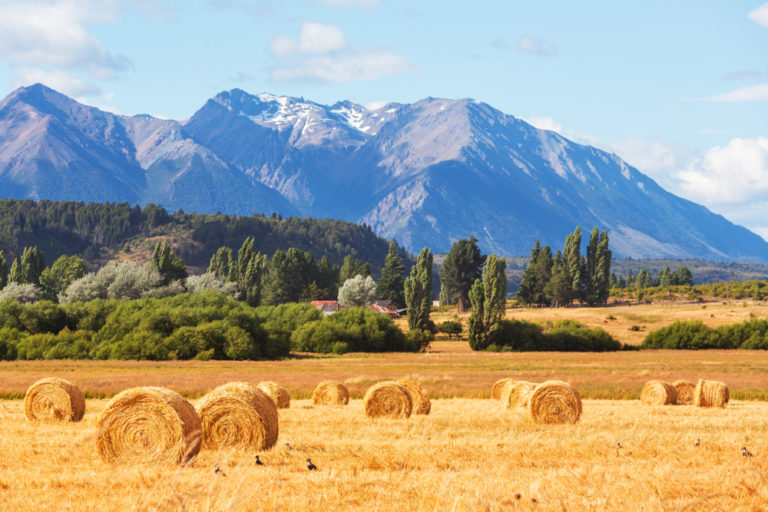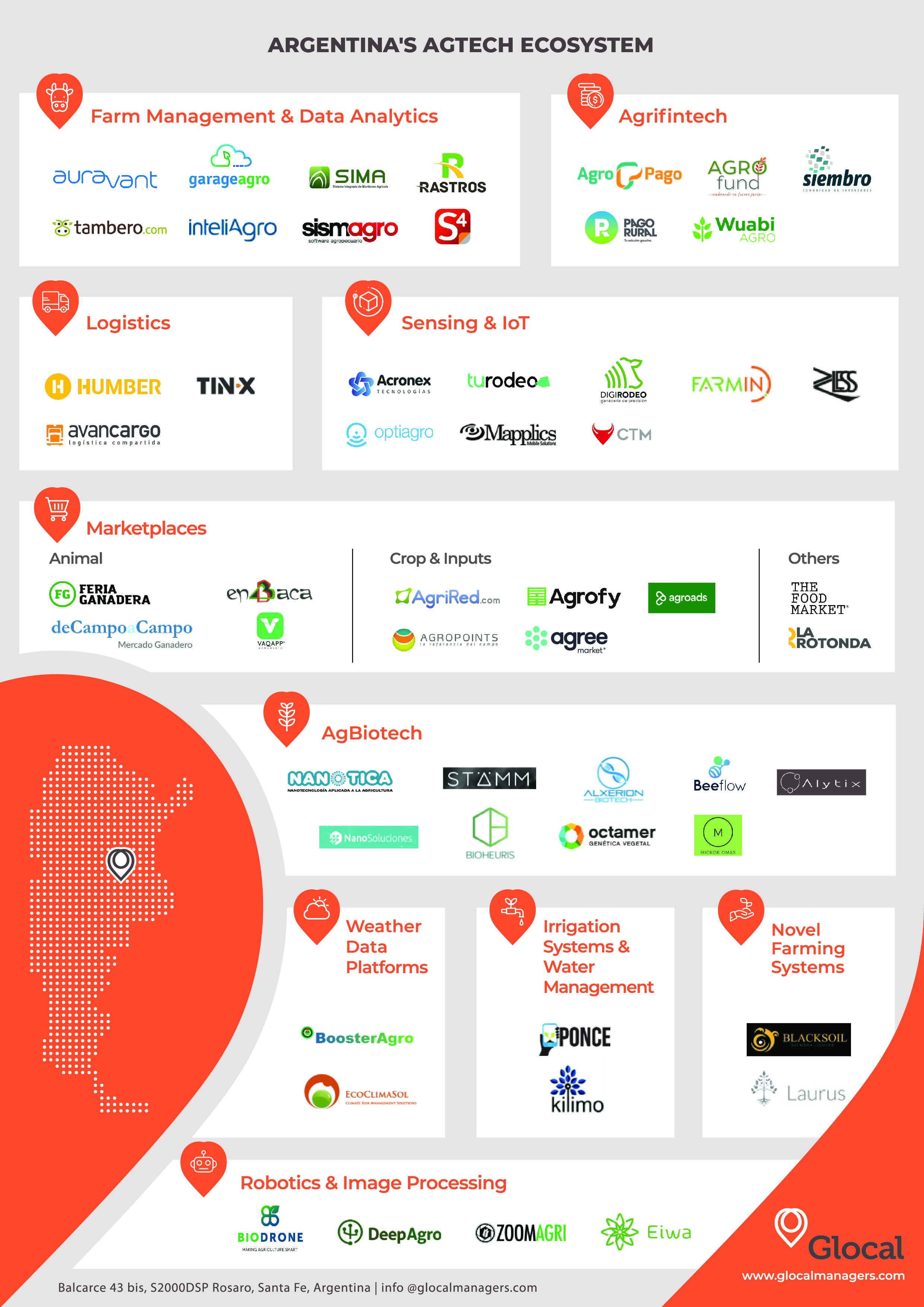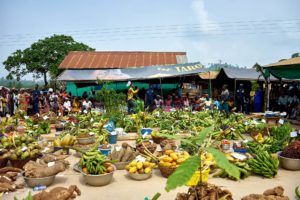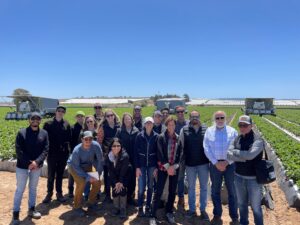Argentina is making moves to become a regional center for agtech startups and innovation.
There are a few key ingredients to a successful startup ecosystem including high-quality entrepreneurs, an active investor community, startup support, and research resources.
Also key is a clear way for investors and entrepreneurs to exit their startups for a return, so the acquisition of two Argentinian agtech businesses this year hinted at the opportunity and potential for Argentina’s agtech sector. King Agro, the carbon fiber products developer that increases the efficiency of sprayer booms, and PLA, a sprayer, planter, and specialty products manufacturer, were both acquired by John Deere earlier this year.
Various organizations in the country are collaborating to make a concerted effort to promote Argentina’s strengths in agtech. AgTech Week in August, organized by the government’s Agencia Argentina de Inversiones y Comercio Internacional, together with investor groups, farmer associations, and entrepreneurs, started an important conversation with international delegates around how the country can foster ag innovation and attract investment.
After a volatile decade under the presidency of Cristina Fernandez who saw off foreign investors with populist policies such as the nationalization of the country’s largest energy company, President Mauricio Macri, who took office in 2015, is working hard to open up Argentina’s markets and attract investment from overseas. Macri’s government has identified agtech as a key sector that could help drive growth in the country, combining Argentina’s strengths in agriculture, entrepreneurship, and a reviving venture capital industry.
The government is putting its money where its mouth is; through the Entrepreneurship Law it is investing in venture capital funds and accelerators. including some focused on agtech. And last week it announced plans for a $600 million microwave imaging satellite to monitor natural disasters and soil moisture. The radar antennae technology will allow Argentina to access a real-time ‘water map,” which will predict harvest yields, floods, and droughts, the government said, according to Reuters.
“There is deep involvement from the government in agtech,” Federico Mayer, founder of Club AgTech, told AgFunderNews. “Without their support, we could still have organized all of the meetings we had during AgTech week, but they would have been isolated events. It would have been impossible to have all of them bounded at AgTech week.”
International investors are starting to pay attention to Argentinian agtech startups too: Agrofy, the agribusiness marketplace, raised $6 million in Series A funding from Syngenta Ventures and Bunge Ventures earlier this year, for example.
There are several hundreds of startups operating in the agtech sector, according to Glocal, the country’s first agtech accelerator. The map below shows 54 startups that are currently in operation and gaining traction across all the key categories including Ag Biotech, Agribusiness Marketplaces, Farm Management Software, Sensing & IoT, Novel Farming Systems, according to Bernardo Milesy, founder of Glocal.
This is still some way away from other ecosystems that have a greater number of startups – local VC SP Ventures says there are 338 in Brazil, for example, but many local players believe the country has the attitude and resources necessary to accelerate growth rapidly.
Here are the key components of Argentina’s agtech ecosystem so far.
Innovative Farmers
What sets the country apart from others, including the US, which is home to the largest number of agtech startups, is the innovative mindset and entrepreneurial spirit of Argentine farmers. Aapresid, the leading farmer association, has for years prioritized technology at its annual event, where AgTech Week culminated between August 8 and August 10, 2018.
In fact, a large number of agtech entrepreneurs are farmers or have experience in the farming industry, contrasting with the US where most come from technology backgrounds.
While this is perhaps unsurprising for a country where agriculture has long provided the backbone of the economy, representing nearly 50% of exports and up to 20% of GDP in years past (11% today), understanding the farmer and his needs is essential if agtech products are to be adopted on the farm.
“There are many challenges related to building a bigger ecosystem, but it is crucial for all players to really understand the ways farmers are going to adopt technology,” said Glocal’s Milesy. “Sometimes there are technologies that sound really good, but they do not resolve something crucial for the farmers or the supply chain; they are marginal solutions. It’s crucial to think in propositions that solve bigger problems in a simple and iterative way. There is enough money waiting for this kind of value propositions.”
The innovative mindset of Argentina’s farmers could set the country apart from other markets like the US where farmers complain of agtech fatigue with a stream of Silicon Valley-type entrepreneurs knocking on their doors requesting access to their acres to trial their technologies.
“Argentina has strength in needing to be innovative across their businesses to combat inflation and other challenges, thus they look to adopt best technologies,” said Aaron Magenheim, founder of Californian consultancy AgTech Insight. “When markets are bad, Argentine growers innovate and open their wallets to double down, in stark comparison to US farmers who close their checkbooks and hope to save money and wait it out.”
“We see more Argentine farmers travel to Silicon Valley and St Louis than any other country, probably by four times,” he added.
Marcelo McGrech from Banco Galicia, Argentina’s leading agriculture bank, agrees that Argentine farmers are very receptive to technology: “When a farmer detects the added value of a technology, he immediately adopts it. We have a very efficient and results-oriented ecosystem of farmers in Argentina. There is a long history of the adoption of technology [and new farming methods] in Argentine agriculture; for example, the adoption of no-till practices and autonomous harvesting equipment.”
Some 90% of Argentine farmers have adopted no-till soil management, where they do not plow the land before sowing seed each year, which has many benefits including reduced soil erosion and increased soil carbon.
Farmers are also putting their money behind agtech by providing angel and seed capital to many startups.
Bioceres, one of the most successful agtech businesses in the country, was started by a group of farmers. Other startups backed by farmers include S4, Kilimo, Auravant, Agrofy, and Acronex.
Julián Baldunciel is a farmer, entrepreneur (founder of Acronex) and agtech investor.
“Argentine farmers have a high level of technological understanding and adoption,” he told AgFunderNews. “Their innovative spirit is the key. They have never received a subsidy; on the contrary, they had to handle extra taxes and economic instability. Being an entrepreneur is in our DNA, and the need comes from the history of our country; it is cultural and transcends generations.”
Local Investors
The venture capital industry in Argentina is on track for a record-breaking year of fundraising, according to Tech Crunch. While its largest VC firms are still small compared to Western standards, they are raising exponentially larger funds this year than before with the support of the government’s Entrepreneurship Law.
Two of the country’s largest tech funds — NXTP Labs and Draper Cygnus — have agtech-dedicated tracks. In fact, NXTP Labs has a dedicated regional accelerator focused on the industry.
There are at least five more early-stage startup accelerators, and resources focused on agtech including Glocal, The Yield Lab, Wayra Argentina, a farmer-founded group called Nest, and CITES. The government also has funding programs for seed stage startups as well as grants for scientific-based startups.
There is a lack of corporate venture capital activity, however, according to Camila Petignat from The Yield Lab.
“There are still not enough local corporate investors, and it will take time for agricultural machinery, food producers, corporate farmers, and inputs companies to really take a deep dive into the CVC world,” she said. Once a few initiatives aimed at encouraging more investment from farmers take hold “we are very confident that once they understand the risks and the rules of engagement, they will pick up the pace really fast investing in their local players developing small startups that convert those old excel macros in fully integrated and sophisticated algorithms,” she added.
There is also uncertainty about the level of investor support for agtech startups beyond the earlier stages and into the growth stage, but this is not specific to Argentina.
Research and Testing
There are a few avenues for Argentine agtech startups to take in the research and development of their tools. Taking part in AgTech Week were government-backed research institutions INTA and CONICET, who showcased various research projects with ag biotech and digital agtech tools, as well as collaborations with startups such as Nanotica, a nanotechnology to reduce the amount of inputs applied to crops.
However, while these institutions are useful for validating technologies, the timelines they work to might not be suitable for startups that need more immediate results, according to Petignat. “There is [also] still a lot of work to do for both parties to speak the same language. Currently, agtech startups are keener to test their products with their first customers or farmer associations likes AAPRESID. There is a more co-development approach of new agtech that reduces the risk of developing solutions for non-existent problems.”
Challenges
Notwithstanding the economic backdrop of Argentina, where the currency plummeted near to an all-time low against the dollar last week despite a $7 billion bailout package from the International Monetary Fund, there are other challenges ahead for Argentina’s agtech sector.
According to The Yield Lab’s Petignat, the mindset of Argentina’s entrepreneurs could hold them back.
“In Argentina, we are very used to operate under the shortage logic; we are very creative to find the way to do business under the worst circumstances, we are resilient and flexible to adapt rapidly to sudden changes… but not very good at thinking ‘if I don’t have limitations, what would I do;’ that logic of abundance is very a difficult switch for us to make. Once companies realize that this is the new way to conduct business and turn knowledge into products, we should see big changes.”
Baldunciel believes the biggest challenge for the industry will be whether farmers can afford to purchase new agtech products.
“I think the key to strengthening the adoption of agtech is to finance the products and services offered by agtech companies at reasonable terms and interest rates in conjunction with the providers,” he added.
McGrech from Banco Galicia says that farmers can, and do access loans to purchase new agtech tools, particularly for more sophisticated agricultural machinery.
“Any farmer who qualifies as a bank customer can access loans to acquire technology, as long as [his] cash flow pays the investment. In an inflationary context like that of Argentina, the farmer has the advantage of being able to take dollar loans, since his production is quoted in that currency; this means lower rates. At the bank, we are working continuously to generate new tools to offer our customers as we consider the farmer the base of a long value chain.”
But without a more stable business climate, it could be hard for startups to get the support system they need to develop these technologies, particularly from the international investor community. Let’s hope Macri’s positive economic policies can remain in place for a long enough term to provide some stability.


















Sponsored
3 challenges agtech startups can overcome with equipment leasing